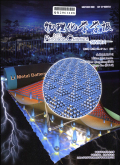物理化学学报2024,Vol.40Issue(3):29-30,2.DOI:10.3866/PKU.WHXB202304044
磷掺杂碳负载ZnxPyOz常温常压下高效电催化合成氨
P-Doped Carbon-Supported ZnxPyOz for Efficient Ammonia Electrosynthesis under Ambient Conditions
摘要
Abstract
The development of efficient synthetic routes for ammonia(NH3)production is the cornerstone of the modern industrial processes and human survival.Owing to the chemical inertness of nitrogen,the current ammonia industry suffers from high energy consumption and high CO2 emission.Electrochemical nitrogen reduction reaction(NRR)provides a promising alternative to the energy-intensive Haber-Bosch(HB)process,enabling green and sustainable NH3 production.However,a low NH3 yield and limited energy conversion efficiency due to the chemical inertness of N2 and competitive hydrogen evolution reaction(HER)are still critical challenges in artificial nitrogen fixation using the electrochemical NRR.Herein,we report a hole-enriched P-doped carbon(PC)-supported Zn3(PO4)2/Zn2P2O7 nanocomposite(h-PC/Zn3(PO4)2/Zn2P2O7)for efficient electrocatalytic conversion of N2 to NH3 in both acidic and neutral media.Remarkably,the unique hierarchical porous structure of the h-PC/Zn3(PO4)2/Zn2P2O7 catalyst improves the surface roughness and facilitates the diffusion of N2 within the catalyst layer,thereby prolonging the residence time of N2 and improving the utilization of active sites.The uniform distribution of multiple components modulates the electronic structure of the active sites and optimizes the adsorption behavior of various reaction intermediates,enhancing the intrinsic activity of the catalyst.Benefiting from the porous structure and multicomponent active sites,including the Zn species and PC,the h-PC/Zn3(PO4)2/Zn2P2O7 achieves an excellent NRR performance with an NH3 yield rate of 38.7±1.2 μg·h-1·mgcat-1 and Faradaic efficiency(FE)of 19.8%±0.9%at-0.2 V vs.reversible hydrogen electrode(RHE)in 0.1 mol·L-1 HCl electrolyte.Moreover,it delivers a high NH3 yield rate of 17.1±0.8 μg·h-1·mgcat-1 with an FE of 15.9%±0.6%at-0.2 V vs.RHE in 0.1 mol·L-1 Na2SO4 solution,which is superior to those of PC/Zn3P2,C/ZnO,and many other non-noble-metal-based electrocatalysts.Ex situ X-ray photoelectron spectroscopy(XPS),transmission electron microscopy(TEM),and X-ray diffraction(XRD)studies were conducted to monitor the changes in the composition and structure of h-PC/Zn3(PO4)2/Zn2P2O7 after being used in NRR.In particular,a new signal of N appeared in the XPS profile after NRR,confirming the occurrence of NRR.This work provides a new strategy for synchronously constructing mass transfer channels and coupling different active sites to synergistically enhance the NRR activity and selectivity of a catalyst,which is of great significance in progressing the industrialization of green ammonia production.关键词
氮气还原反应/电催化剂/孔结构/多活性中心/协同效应Key words
Nitrogen reduction reaction/Electrocatalyst/Porous structure/Multiple active center/Synergistic effect分类
化学引用本文复制引用
王佳,秦清,王哲,赵旭浩,陈云菲,候利强,刘尚果,刘希恩..磷掺杂碳负载ZnxPyOz常温常压下高效电催化合成氨[J].物理化学学报,2024,40(3):29-30,2.基金项目
The project was supported by the Taishan Scholar Program of Shandong Province(ts201712045,tsqn202211162),the National Natural Science Foundation of China(22102079),and the Natural Science Foundation of Shandong Province(ZR2021YQ10).山东省泰山学者人才工程(ts201712045,tsqn202211162),国家自然科学基金(22102079)和山东省自然科学基金(ZR2021YQ10)资助项目 (ts201712045,tsqn202211162)

